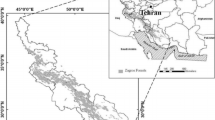Abstract
The research was conducted on the outskirts of Yogyakarta City that administratively include three districts of Sleman Regency, namely Depok, Gamping, and Mlati, and three districts of Bantul Regency, namely Kasihan, Sewon, and Banguntapan. It aimed to obtain a deeper understanding on the perceptions of stakeholders on the regional transformation phenomena occurring on the outskirts of Yogyakarta City. This is a qualitative case study research with a single case. The case study research method was selected because the observed phenomenon is contemporary and the analyzed issue is unique. It used a qualitative method with field observations and in-depth interviews to several informants as data acquisition techniques. The informants were stakeholders from state/government, private sector/entrepreneur, academics, and civil society, which were selected using purposive sampling method. The research data processing and analysis included: (1) data reduction, (2) data presentation, and (3) data conclusion. In order to examine the reliability and validity of the data, the research used source triangulation method. The results showed that all stakeholders perceived the regional transformation on the outskirts of Yogyakarta City to have positive and negative consequences on various dimensions. The positive ones were the economic opportunities, generated by the regional transformation process, for both the native people and the migrants. Aside from these positive consequences, the regional transformation on the outskirts of Yogyakarta City also caused negative impacts on the physical, economic, social, and cultural dimensions of the outskirts.


Similar content being viewed by others
References
Beesley, K., & Russwurm, L. H. (1986). The rural urban fringe: Canadian perspectives., Geographical monograph Toronto: York University.
Bryant, C. R., Russwurn, L. H., & McLellan, A. G. (1982). The city’s countrysides: Land and its management in rural urban fringe. New York: Longman Inc.
Dharmapatni, I. A. I. (1993). Fenomena Mega Urban dan Tantangan Pengelolaannya. Jurnal Perencanaan Wilayah dan Kota, 4(9a), 26–43.
Firman, T. (1992). The spatial pattern of urban population growth in Java 1980–1990. Bulletin of Indonesian Economics Studies, 28(2), 25–37.
Firman, T. (1994). Urban restructuring in Jakarta Metropolitan Region: An integration into a system of global cities. In Proceeding of the Conference on Cities and the New Global Economy, the Government of Australia and OECD (pp. 115–124).
Friedman, J. P. (1973). The spatial organization of power in the development of urban system. Development and Change, 4(3), 12–50.
Giyarsih, S. R. (2014). The role of Yogyakarta and Surakarta cities in the intensity of the regional transformation of two villages located in the Yogyakarta–Surakarta corridor. Romanian Review of Regional Studies, X(1), 15–22.
Li, Y., Li, Y., Westland, H., & Liu, Y. (2015). Urban-rural transformation in relation to cultivated land conservation in china: Implications for optimizing landuse and balance regional development. Land Use Policy, 47, 218–224.
McGee, T. G. (1997). The extended metropolis and settlement transsition in Asia: The emergence of Desa-Kota in Asia: Expanding a hypothesis. Honolulu: The University of Hawaii Press.
Nopiyanto, E. R. (2015). Preferensi Pemukim Perumahan Sidorejo Terhadap Lokasi Tempat Tinggal di Desa Sidorejo. Thesis, Fakultas Geografi UGM.
Oueslati, W., Alvanides, S., & Garrod, G. (2015). Determinants of urban sprawl in European cities. Urban Studies, 52(9), 1594–1614.
Rachmawati, R., Subanu, L. P., & Rijanta, R. (2004). Peranan Kampus Sebagai Pemicu Urbanisasi Spasial di Pinggiran Kota Yogyakarta. Majalah Geografi Indonesia, 18(1), 13–25.
Ryha, S. (2008). Persepsi Stakeholders Terhadap Pengelolaan Sumberdaya Wilayah Pesisir di Kabupaten Wakatobi Sulawesi Tenggara (Studi Kasus Desa Mola Selatan, Sama Bahari, dan Lamanggau). Thesis, Fakultas Geografi UGM.
Saktiyana, T. (2015). Alih Fungsi Lahan Bantul Capai 80%. Perlu Pengendalian. Media Informasi Properti, IV(39), 40–41.
Sihana, M. (2015). Perubahan Penghidupan Sosial Ekonomi Penduduk Desa Wedomartani Akibat Pembangunan Kawasan Stadion Maguwoharjo. Thesis, Fakultas Geografi UGM.
Sudrajat, S. (2016). Farmers commitment in maintaining wetted land ownership status in peri urban area of Yogyakarta. Indonesian Journal of Geography, 48(1), 91–101.
Tacoli, C. (2003). The links between urban and rural development. Environment and Urbanization, 15(1), 3–12.
The Local Government of Bantul Regency. (2011). Local Regulation of Bantul Regency No. 04 in 2011 on the Spatial Planning of Bantul Regency in 2010 to 2030. Yogyakarta: The Local Government of Bantul Regency.
Tukiran, (2012). Metode Penelitian Survai. Jakarta : LP3ES.
Wang, W., Liu, Y., Li, Y., & Li, T. (2016). The spatio temporal pattern of urban–rural development transformation in China since 1990. Habitat International, 53, 178–187.
Wei, F., & Knox, P. L. (2015). Spatial transformation on metropolitan cities. Environment and Planning A, 47(1), 50–68.
Wilonoyudho, S. (2011). Determinan dan Dampak Urbanisasi Berlebih di Kota Semarang. Dissertation, The Doctoral Program of Universitas Gadjah Mada Graduate School.
Winarso, H., Hudalah, D., & Firman, T. (2015). Peri urban transformation in the Jakarta metropolitan area. Habitat International, 49(1), 221–229.
Yunus, H. S. (2008). Dinamika Wilayah Peri Urban, Determinan Masa Depan Kota. Yogyakarta: Pustaka Pelajar.
Acknowledgements
Authors would like to express their gratitude to the Graduate School of UGM for providing research funding through the scheme of Competitive Graduate-School Lecturer Research Grant in 2015. Authors would also like to thank Prof. Dr. Sunarru Samsi Hariyadi, and Dr. Lono Lastoro Simatupang, for their significant inputs in improving this article.
Author information
Authors and Affiliations
Corresponding author
Rights and permissions
About this article
Cite this article
Giyarsih, S.R., Marfai, M.A. The perception of stakeholders on regional transformation on the outskirts of Yogyakarta City, Indonesia. GeoJournal 83, 983–991 (2018). https://doi.org/10.1007/s10708-017-9812-9
Published:
Issue Date:
DOI: https://doi.org/10.1007/s10708-017-9812-9




